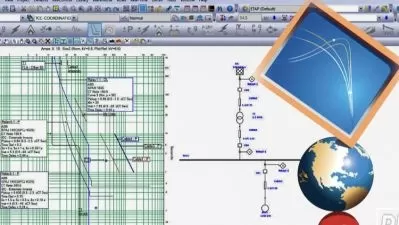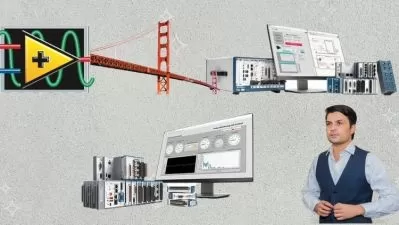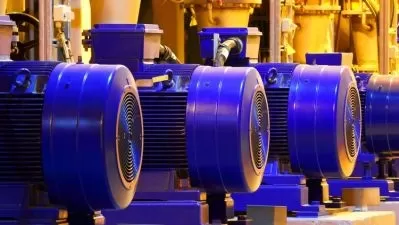Design of Electric Motors from scratch
Mohammed Tafesh
45:53
Description
Learn the basics of electric motor design ( AC and DC Motors )
What You'll Learn?
- Knowledge of the design of electric motors of all kinds
- The working principle of DC motors and AC motors
- Methods for speed control of DC and AC motors
- Types and shapes of AC and DC motors and functions of their internal components(
- Design calculations and basic equations for AC and DC motors
Who is this for?
What You Need to Know?
More details
DescriptionIn this course, you will learn the design of all types of electric motors used in various daily life applications, including electrical appliances in homes, machines and electrical machines used in factories, production lines, well pumps, sewage, irrigation and many others..
In this course you will learn :
Design of electric motors of all kinds
The working principle of DC motors and AC motors
Methods for controlling the speed of DC and AC motors
Types and forms of AC and DC motors and the functions of their internal components
Design calculations and basic equations for AC and DC motors
In this course you will be able to:
Distinguishing the types of electric motors in all their shapes and types
Understand and know the technical data for the design of electric motors
Operation of AC and DC motors in electrical circuits
Choosing the necessary motors in the application of projects, as in factories and electrical machines
Design of motors in practical workshops and laboratories
The development of electric motors began at the beginning of the nineteenth century with the discovery of electromagnets. In 1820 AD, the Danish physicist Hans Christian Oersted discovered that a wire in which an electric current passes generates a magnetic field around it (around the current). When the current passes through a looped wire (formed in the form of a loop), the generated magnetic field will be more intense inside the loop, and the direction of the field will be perpendicular to the plane of the loop. In the late 1820s, American physicist Joseph Henry showed that a more powerful electromagnet could be created by wrapping several turns of insulated wire around a piece of iron, i.e. acting like a magnet.
In 1821 AD, the English physicist Michael Faraday suspended a wire of copper and dipped it in a container of mercury, and in the mercury was a magnetic rod. When Faraday passed an electric current through the wire, he found that it began to revolve around the magnetic base in mercury. Faraday found that the electric current created a circular magnetic field around the wire.
In 1827, the Hungarian physicist, Aniosh Yedlik, conducted an experiment using wire files. He modified the experiment so that the motor consisted of three components of a direct current motor: a fixed member, a rotating member, and an electric exchanger. This device does not use a self-magnet, but the magnetic fields are produced by the two electric currents passing through the stator windings and the rotating member windings.
In 1873 AD, the first commercially successful direct current motor appeared, as it was demonstrated by a Belgian electrical engineer named Zenob Theophile Gram in Vienna. Gram also presented a portfolio that would improve the efficiency of primitive electric motors and generators.
In 1888 AD, an engineer of Serbian origin named Nikola Tesla invented the alternating current motor. At the beginning of the twentieth century AD, many advanced electric motors were developed.
In the first decade of the twentieth century, many engineers and inventors experimented with linear electric motors. Instead of rotating, such motors produce an electromagnetic wave that can directly drive a vehicle. The use of linear actuators became more common thanks to the pioneering work of electrical engineer Eric Lethwaite in the 1950s and 1960s.
Who this course is for:
- The course targets those interested in the field of electricity and workshops
- The course targets engineers and technicians in the field of electrical engineering and electrical machines
In this course, you will learn the design of all types of electric motors used in various daily life applications, including electrical appliances in homes, machines and electrical machines used in factories, production lines, well pumps, sewage, irrigation and many others..
In this course you will learn :
Design of electric motors of all kinds
The working principle of DC motors and AC motors
Methods for controlling the speed of DC and AC motors
Types and forms of AC and DC motors and the functions of their internal components
Design calculations and basic equations for AC and DC motors
In this course you will be able to:
Distinguishing the types of electric motors in all their shapes and types
Understand and know the technical data for the design of electric motors
Operation of AC and DC motors in electrical circuits
Choosing the necessary motors in the application of projects, as in factories and electrical machines
Design of motors in practical workshops and laboratories
The development of electric motors began at the beginning of the nineteenth century with the discovery of electromagnets. In 1820 AD, the Danish physicist Hans Christian Oersted discovered that a wire in which an electric current passes generates a magnetic field around it (around the current). When the current passes through a looped wire (formed in the form of a loop), the generated magnetic field will be more intense inside the loop, and the direction of the field will be perpendicular to the plane of the loop. In the late 1820s, American physicist Joseph Henry showed that a more powerful electromagnet could be created by wrapping several turns of insulated wire around a piece of iron, i.e. acting like a magnet.
In 1821 AD, the English physicist Michael Faraday suspended a wire of copper and dipped it in a container of mercury, and in the mercury was a magnetic rod. When Faraday passed an electric current through the wire, he found that it began to revolve around the magnetic base in mercury. Faraday found that the electric current created a circular magnetic field around the wire.
In 1827, the Hungarian physicist, Aniosh Yedlik, conducted an experiment using wire files. He modified the experiment so that the motor consisted of three components of a direct current motor: a fixed member, a rotating member, and an electric exchanger. This device does not use a self-magnet, but the magnetic fields are produced by the two electric currents passing through the stator windings and the rotating member windings.
In 1873 AD, the first commercially successful direct current motor appeared, as it was demonstrated by a Belgian electrical engineer named Zenob Theophile Gram in Vienna. Gram also presented a portfolio that would improve the efficiency of primitive electric motors and generators.
In 1888 AD, an engineer of Serbian origin named Nikola Tesla invented the alternating current motor. At the beginning of the twentieth century AD, many advanced electric motors were developed.
In the first decade of the twentieth century, many engineers and inventors experimented with linear electric motors. Instead of rotating, such motors produce an electromagnetic wave that can directly drive a vehicle. The use of linear actuators became more common thanks to the pioneering work of electrical engineer Eric Lethwaite in the 1950s and 1960s.
Who this course is for:
- The course targets those interested in the field of electricity and workshops
- The course targets engineers and technicians in the field of electrical engineering and electrical machines
User Reviews
Rating
Mohammed Tafesh
Instructor's Courses
Udemy
View courses Udemy- language english
- Training sessions 21
- duration 45:53
- Release Date 2023/07/29














![Python for Signal and Image Processing Master Class [2023]](https://traininghub.ir/image/course_pic/16810-x225.webp)


